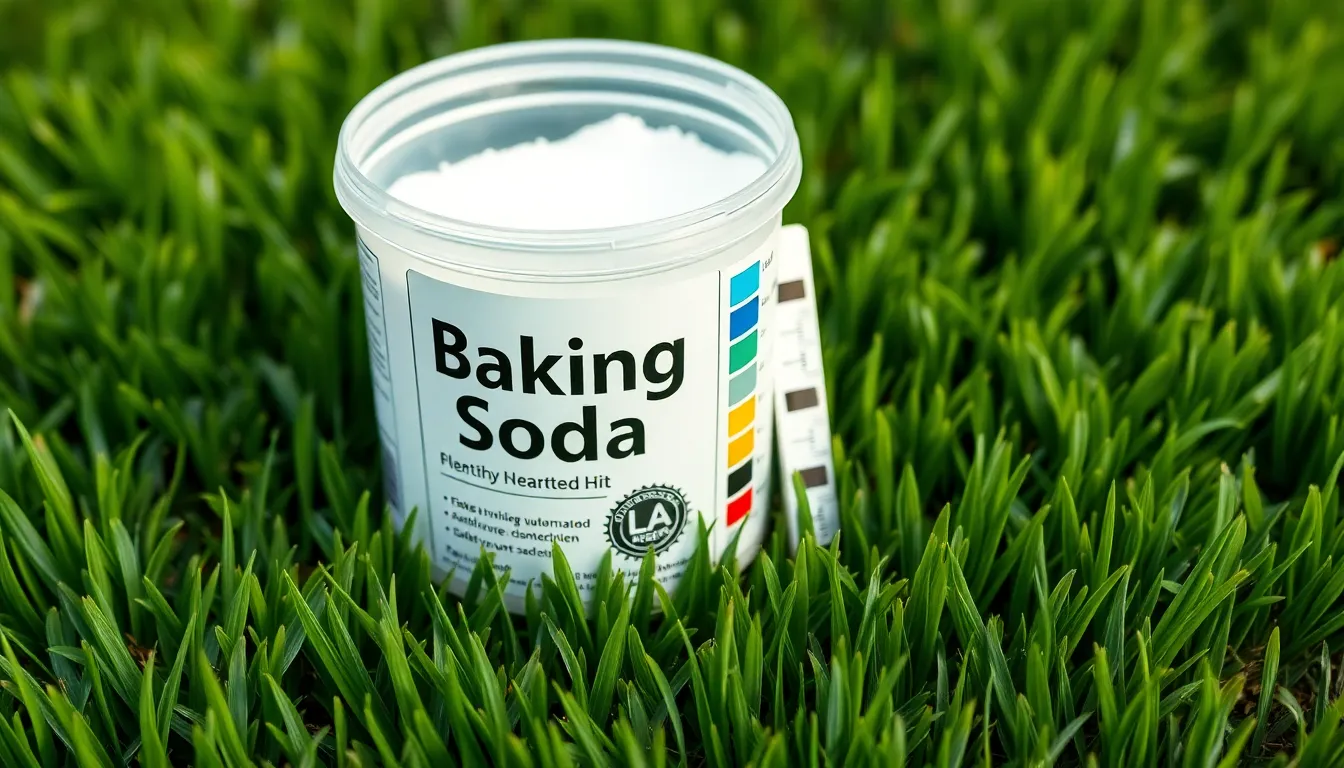Table of Contents
ToggleWhen it comes to lawn care, some folks will try just about anything to keep their grass looking lush and green. Enter baking soda, the kitchen superhero that saves cookies and muffins from mediocrity. But can this pantry staple double as a grass assassin?
Picture this: you sprinkle a little baking soda on your lawn, and suddenly, your grass is waving goodbye. It sounds like a plot twist straight out of a gardening horror movie. Yet, before you start planning a baking soda massacre, it’s essential to uncover the truth behind this common household item and its effects on your beloved turf. Let’s dive into the science and myths surrounding baking soda and grass, and find out if it’s a friend or foe in your quest for the perfect lawn.
Understanding Baking Soda
Baking soda, or sodium bicarbonate, is a versatile compound with distinct properties. Its alkaline nature influences its interaction with various substances.
Composition and Properties
Sodium bicarbonate consists of sodium ions and bicarbonate ions. This chemical structure gives it a mildly alkaline pH, typically around 8.3. Such alkalinity can affect soil chemistry by altering acidity levels. Grass thrives in slightly acidic to neutral soil, with an ideal pH of 6 to 7. Therefore, excessive application of baking soda could disrupt this balance, stressing or killing grass. While it serves as a leavening agent in baking, its use in large quantities can be harmful when applied to lawn care.
Common Uses in Gardening
Baking soda finds various applications in gardening practices. Gardeners often utilize it as a natural fungicide, effectively treating powdery mildew on plants. It acts as a deterrent against certain pests, including aphids and slugs, thanks to its abrasive texture. Additionally, many gardening enthusiasts incorporate baking soda in homemade compost to help regulate pH levels. Soil amendment represents another benefit, aiding in the breakdown of nutrients. Despite these uses, careful consideration of application amounts is crucial to prevent potential grass damage.
Impact of Baking Soda on Grass

Baking soda has notable effects on grass health and soil quality. Understanding these impacts helps in making informed decisions for lawn care.
Effects on Soil pH
Baking soda raises soil pH, leading to more alkaline conditions. Grass prefers a slightly acidic to neutral pH range, typically between 6 and 7. Applying excessive amounts of baking soda disrupts this balance, which can stress the grass. An increase in alkalinity may result in nutrient deficiencies, affecting grass growth. Monitoring soil pH after application remains essential to prevent harm. Research indicates maintaining optimal pH levels enhances grass vitality and resilience.
Potential Toxicity Levels
Baking soda’s toxicity levels depend on application quantity and frequency. When used in moderation, it serves beneficial purposes, such as controlling pests and diseases. However, overdosing can lead to toxicity, putting grass at risk. Grass may exhibit signs of stress, including yellowing leaves and wilting. Moreover, studies show high sodium content can be detrimental, leading to soil structure degradation. Following recommended guidelines ensures safety and effectiveness in lawn applications.
Scientific Studies on Baking Soda and Grass
Baking soda’s effects on grass health attract scientific scrutiny. Several studies explain its impact on soil chemistry and grass vitality.
Relevant Research Findings
Research indicates that baking soda can significantly alter soil pH levels. One study shows that applying baking soda raises pH, which creates more alkaline conditions detrimental to grass growth. Increased alkalinity can impede nutrient absorption. Specifically, nitrogen, phosphorus, and potassium deficiencies occur, leading to poor grass health. Experiments confirm that excessive application results in visible signs of distress, such as yellowing leaves, stunted growth, and soil structure degradation. Proper application must remain in moderation to maintain lawn vitality.
Expert Opinions
Experts caution against using baking soda excessively for lawn care. They emphasize that grass prefers slightly acidic to neutral soil. Recommendations consistently advise monitoring soil pH after application. Many professionals highlight the importance of conducting soil tests before and after using baking soda. Soil amendments should remain well-balanced, ensuring grass can thrive. Consultations with horticulturists or agronomists provide additional insights into safe practices for using baking soda in lawns. Overall, expert consensus favors careful, limited use of baking soda as part of an integrated lawn care strategy.
Methods of Application
Baking soda application methods significantly influence its effect on grass health. Heavier use may result in adverse outcomes, while moderated methods can offer benefits.
Direct Application
Directly applying baking soda on grass can yield immediate results but requires caution. Gardeners often sprinkle it directly onto affected areas, targeting specific spots like weed infested patches. This method delivers a concentrated dose, potentially altering localized soil pH. Observing the grass’s response post-application is crucial, as signs of stress like yellowing leaves can appear if overdosed. Careful monitoring and adjusting the amount used helps maintain healthy grass. For effective use, gardening experts recommend limited application to prevent soil pH imbalances.
Diluted Solutions
Diluted solutions of baking soda provide a gentler approach, minimizing risks to grass health. Mixing one tablespoon of baking soda with one gallon of water creates an effective treatment for localized areas. This method allows for easier distribution and absorption into the soil, reducing the likelihood of direct damage to the grass. Spraying this mixture on affected areas prepares the lawn to benefit from the antifungal properties of baking soda without overwhelming it. Following up with soil pH tests helps ensure balance and avoid potential nutrient deficiencies.
Alternatives to Baking Soda
Exploring alternatives to baking soda for lawn care provides effective options without the potential risks. Numerous solutions exist that can support lawn health while managing weeds.
Natural Weed Killers
Natural weed killers offer a safe, eco-friendly method to control unwanted plants. Vinegar, with its acetic acid, can effectively kill weeds upon contact. Corn gluten meal acts as a pre-emergent herbicide, preventing new weed seeds from germinating. Salt proves effective in small doses, but it can also harm surrounding grass if overapplied. Essential oils, such as clove and peppermint, serve as natural herbicides due to their strong scents and properties. These methods contribute to a healthier lawn while addressing weed problems without the risk of altering soil pH.
Chemical Herbicides
Chemical herbicides provide a stronger approach to weed control for those dealing with persistent infestations. Glyphosate and 2,4-D are common examples that target broadleaf weeds while protecting grasses. Application requires caution, as misuse can harm desirable plant life. Following label instructions ensures safe and effective treatment, minimizing potential damage. Moreover, scheduling treatments during active growth periods enhances effectiveness, allowing herbicides to penetrate plant tissues fully. Chemical options present immediate action, making them suitable for urgent weed issues while complementing overall lawn management strategies.
Baking soda can be a useful tool in lawn care but requires careful handling. While it offers benefits like acting as a natural fungicide, its alkaline nature can disrupt soil pH if overused. This disruption can lead to nutrient deficiencies and visible distress in grass.
For those considering baking soda, moderation is key. Monitoring soil pH and applying it in diluted solutions can help mitigate risks. Exploring alternative methods for lawn care is also advisable to maintain a healthy and vibrant lawn. By using baking soda wisely and being aware of its potential effects, lawn enthusiasts can achieve a balanced approach to grass health.




